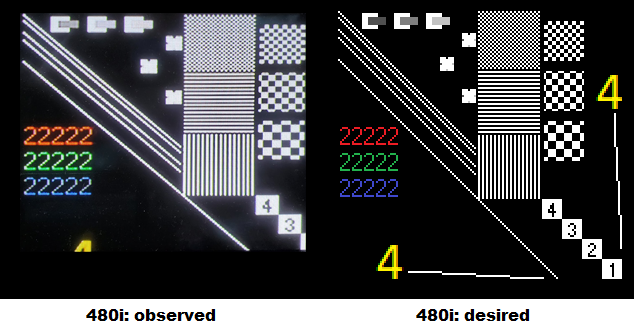This 1080p TV from 2010 has a good picture better than average input lag and only slightly slow response times. It retailed for around $500 when new.
Overview/Image quality

At 480 this tv has minimal aliasing but does blur the pixels a bit. Every other resolution has aliasing, with the worst being native resolution (1080p), where it's pretty bad. See photo of 1x1 pixel checkerboard at right.
All resolutions crop as well, about 20 pixels off each side. There is an asterisk here, though: there's no way to adjust the zoom/cropping/stretching from the on screen menus, but perhaps with a remote (which I did not have) there's a way? I could only test with the factory defaults.
It has all the standard inputs, including 3 HDMI, VGA, and 2 yPbPr. I only tested HDMI.
Input Lag
This display has no game mode, scene, or color preset. None of the image settings seem to change the lag or response time of the display at all.
I used a piLagTesterPRO to measure input lag. This device sends a frame of video over HDMI and measures how long it takes to display it. This TV was able to properly sync to the refresh rate of the Pi, producing consistent lag values each time it was turned or or inputs were switched.
Full Test Results
I report two kinds of values.
1st response measures how long it takes for the TV to start responding (I use a 5% change in display brightness). This overly optimistic value doesn't tell how long it takes to see anything useful, but matches what other reviewers call
input lag.
full response is a more realistic measure of lag, and requires the display to reach 80% of full brightness. This combines both
input lag and
response time, and is closer to what you would actually experience in a game.
| top | bottom | | |
| Resolution | 1st response | full response | 1st response | full response | scan out | response time |
| 480i | 39.0 | 49.0 | 55.0 | 65.0 | 16.0 | 10.0 |
| 480p | 21.1 | 31.0 | 38.3 | 48.0 | 17.2 | 9.9 |
| 720p | 20.3 | 30.0 | 37.2 | 47.0 | 16.9 | 9.7 |
| 1080p | 20.6 | 30.0 | 36.4 | 46.0 | 15.8 | 9.4 |
At native resolution this display actually does pretty well, taking just 20ms to start responding, and about 10ms more to finish drawing. It takes a full 16ms to paint the whole screen, so the realistic lag is 46ms. To deinterlace at 480i it only adds another 18ms (~1 frame) but the results aren't that good for moving stimuli.
I measured the responses time for black to white, but also various levels of gray to gray. It was slowest going from full black to full white, a full 12-15ms. Most of the other transitions took much less time, around 6-7ms. This suggests this TV doesn't have overdrive. I will say that a moving bar on a black background looked pretty blurred. Motion looks decent on this set, but not standout at all.
Results compared to other displays
To allow quick comparison between many displays I've summarized the results across all the displays I've personally tested with the piLagTester Pro. Min lag is the first response at the top of the screen, real lag is the full response at the bottom.
(* effective; tv refreshes display instantaneously)
This TV ranks pretty well on input lag. I've sorted this list by 720p real lag, and it's near the top of the TVs I've tested. Though, to be fair about half the TVs on the list are only 5ms slower. So it's better than average to be sure, but not a standout like, for instance, the
Panasonic Plasma TH-58PE75U I tested, or all the computer monitors I tested.
Conclusion
This is a better than average TV for gaming. Many TVs are slower, though not by much for progressive content. The poor aliasing at 1080 was very disappointing, but the 480p results were actually quite good, other than being blurry. And 480i was quite fast by LCD TV standards. It's sad that 65ms of real lag is fast, but in a world where 480i can be as slow as 150ms, you take what you can get!
I would not get it unless you can get a genuine remote for it, however, as the built in controls and menus don't allow adjusting aspect ratio, etc.
Other models
I tested the L40FHD41YX9. I think the last 3 digits are not meaningful, so I called it the L40FHD41 in the review. There's another model, L32HD41, which has the same motherboard design, so it seems highly likely that it will have the same input lag, response time, and upscaling as the L40FHD41YX9, just in a smaller form factor.




Comments